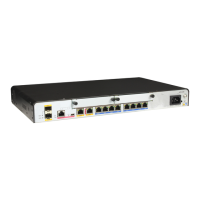2.13.6 Example for Configuring an Outbound LDP Policy
This section describes how to configure an outbound LDP policy, including the operation of
enabling MPLS and MPLS LDP globally.
Networking Requirements
MPLS LDP is configured on the network shown in Figure 2-11. LSRD is a DSLAM functioning
as a low-performance access device. By default, LSRD receives label mapping messages from
all peers and uses the routing information in these messages to establish a large number of LSPs.
As a result, memory on LSRD is overused and LSRD is overburdened. An outbound LDP policy
needs to be configured on LSRB to send LSRD label mapping messages for routes to only LSRC
and to establish LSPs to LSRC, saving resources.
Figure 2-11 Networking diagram of an outbound LDP policy
LSRB
Eth1/0/0
10.1.1.1/24
Eth1/0/0
10.1.1.2/24
LSRA LSRC
Eth2/0/0
10.1.2.1/24
Eth1/0/0
10.1.2.2/24
Loopback1
1.1.1.9/32
Loopback1
2.2.2.9/32
Loopback1
3.3.3.9/32
LSRD
Loopback1
4.4.4.9/32
Eht1/0/0
10.1.3.1/24
Eth1/0/1
10.1.3.2/24
Configuration Roadmap
The configuration roadmap is as follows:
1. Configure the IP address and loopback address of each interface.
2. Configure OSPF to advertise the route to each network segment of each interface and to
advertise the host route to each LSR ID.
3. Enable MPLS and MPLS LDP in the system view and interface view.
4. Configure an outbound LDP policy.
Data Preparation
To complete the configuration, you need the following data:
l IP address of each interface on each LSR as shown in Figure 2-11, OSPF process ID, and
OSPF area ID
l LSR ID of each node
Huawei AR1200 Series Enterprise Routers
Configuration Guide - MPLS 2 MPLS LDP Configuration
Issue 01 (2011-12-30) Huawei Proprietary and Confidential
Copyright © Huawei Technologies Co., Ltd.
95

